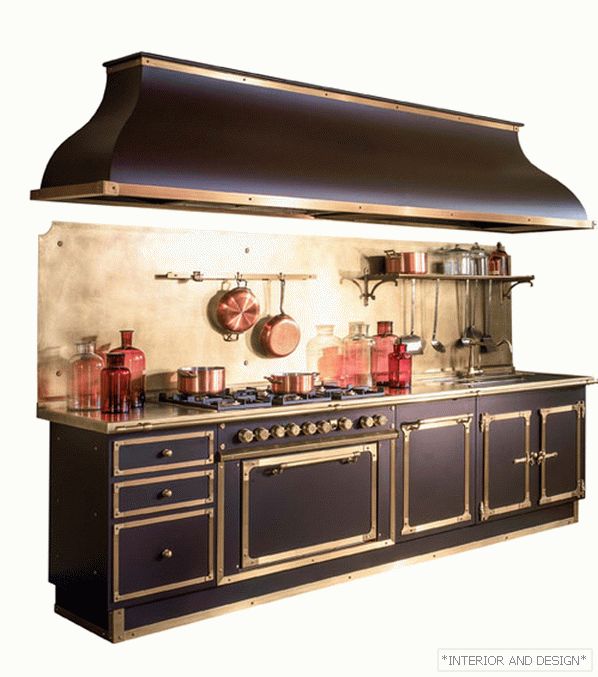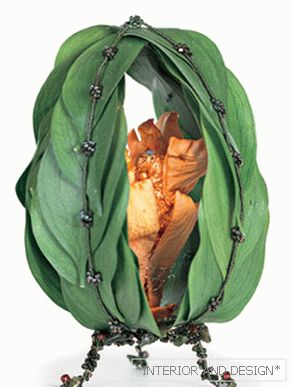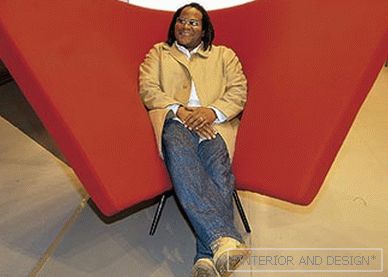American designer Harry Bertoya (Harry Bertoia, 1915-1978) - the author of one of the most famous design creations of the twentieth century - Diamond Chair (1952). Today, his few works, created in the middle of the 20th century for the famous Knoll brand, are usually referred to as reference works of the mid-century modern design. The furniture, which Bertoya designed for Knoll, has never been removed from production since then - today in the company's portfolio are six models created by Bertoya, not counting the various variations. Chair Diamond, released in 1952, immediately became a bestseller and is still popular. This year, at the Knoll stand in Milan, iSaloni, there were presented collections in 18-carat gold.
+ Related: iSALONI 2016: Knoll golden furniture
In 2015, the centenary of the birth of Harry Bertoyi was widely celebrated. Knoll showed a great multimedia retrospective of his work in three major forums: Milan, London and Paris design weeks. The exhibition was designed by the architectural bureau OMA, headed by Rem Koolhaas.
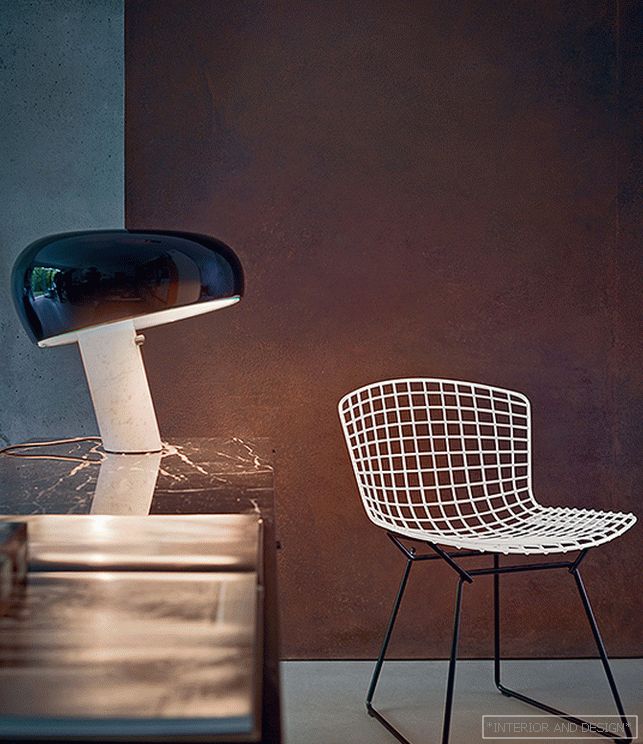 Side Chair. 1952. Knoll. Metal. Produced by the company so far and sold in the United States at a price of $ 750.
Side Chair. 1952. Knoll. Metal. Produced by the company so far and sold in the United States at a price of $ 750. However, furniture design was not the main occupation of Bertoya. He himself called himself a sculptor, although he was engaged in graphics, and created unique jewelry. In his legacy of more than 50 thousand works of art, despite the fact that Bertois lived only 63 years. In the fall of 2016, the New York Museum of Art and Design (Museum of Art and Design) hosts an exhibition of his graphics and jewelry, accompanied by live recordings that he made while playing on his musical sculptures.
Arieto Bertoya was born in 1915 in the north of Italy, in the town of San Lorenzo. His artistic gift manifested itself in childhood: by the order of local brides, he drew lace patterns to decorate wedding linen. At age 15, his father takes him to America, where his elder brother had already settled by that time. There he re-named his name in the American manner - Harry. He studied at the jeweler in the Technical College of Detroit, then he studied painting and drawing at the Detroit School of Art, constantly sending his work to various competitions. In 1937 he received a scholarship from the Cranbrook Academy of Art (Cranbrook Academy of Art) and became a student again.
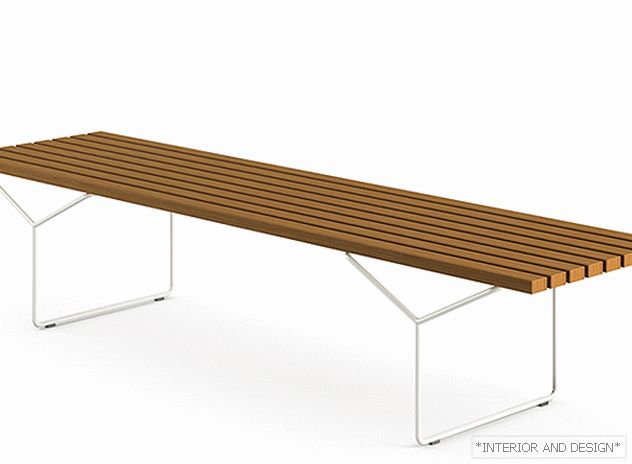 Скамья Slatted Wooden Bench. 1952. Knoll.
Скамья Slatted Wooden Bench. 1952. Knoll. At the end of the 1930s, a special creative environment took shape in Krenbruck, which the Academy is famous for until now: it was not only and not so much a university in the traditional sense, as a kind of creative laboratory and talent incubator. The training took place in the form of master classes conducted by famous artists, sculptors and ceramists. The invited master of architecture was Walter Gropius. Harry Bertoya was such a talented student that after graduation the director, architect Eliel Saarinen (father of Eero Saarinen), offered him to lead a jewelery class at the academy. In Krenbrook, Bertoya met and made friends with many important people for his entire fate: future famous architects Eero Saarinen and Edmund Bacon, designers Ray and Charles Imz, the founders of the Knoll brand Hans and Florence Knoll and, finally, with his future wife Brigitte Valentine, daughter of Wilhelm Valentine, director of the Detroit Institute of Art and then the main US specialist in Rembrandt.
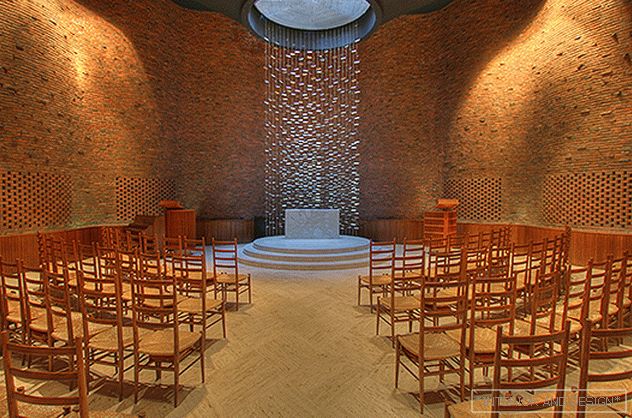 Sculpture in the interior of the Massachusetts Institute of Technology.
Sculpture in the interior of the Massachusetts Institute of Technology. Bertoi's dream is a large-scale work, but because of the war, metal is in short supply, so he has to be content with small forms, and he reaches real heights in this field: his artistic necklaces, brooches and rings were snapped up by ladies with fine artistic taste. They resembled small abstract sculptures - these were vivid examples of the so-called “wearable art” (art to wear) - trends in the design of clothing and jewelry, when each thing is a valuable art object. Bertoya made the original wedding rings for the wedding of Ray and Charles Eames, Ruth and Edmund Bacon and for his own wedding with Brigitte. In his free time in Krenbrook, he was engaged in graphics - he did abstract monotypes and once sent a hundred works to the Guggenheim Museum asking for an artistic appreciation. His answer was stunned: the purchasing director acquired all the works, part for the museum collection, part for himself.
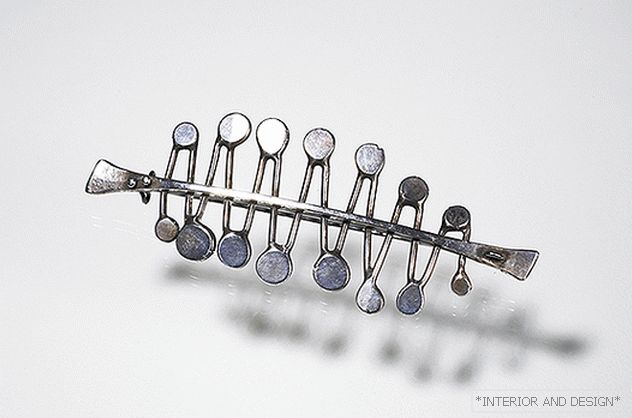 Silver brooch, diz. G. Bertoya.
Silver brooch, diz. G. Bertoya. 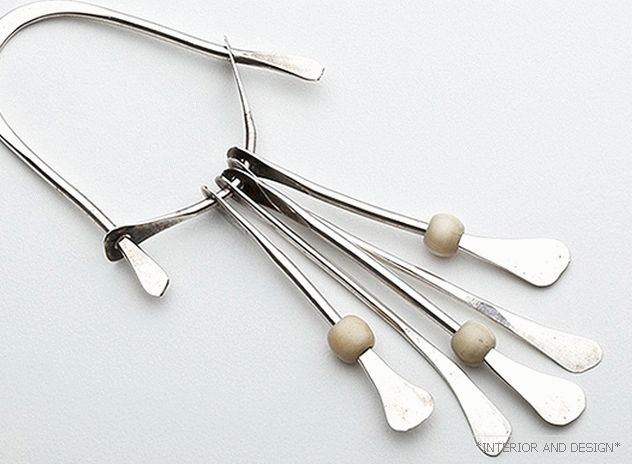 Silver Wish Bone, diz. G. Bertoya.
Silver Wish Bone, diz. G. Bertoya. 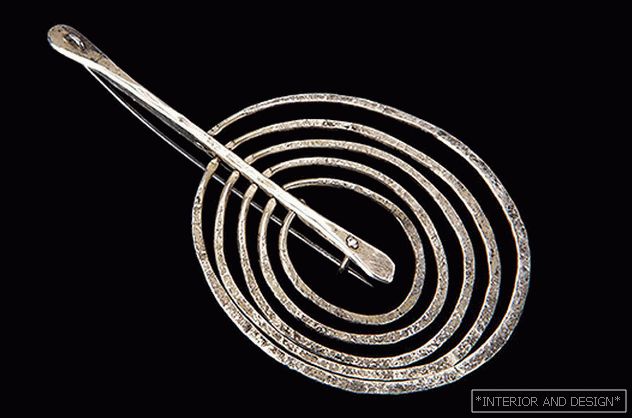 Silver brooch, diz. G. Bertoya.
Silver brooch, diz. G. Bertoya. In 1943, Bertoya and his family moved to California after the Emzes and took an active part in their experiments with plywood. Together they are trying to find a way of industrial production of modern furniture from this material. As a result, in 1946, Imzy, under his own name, released the famous DCW chair made of plywood and never mentioned Bertoi's contribution to its creation. He was offended and broke off relations with them. But here he was found by his other friends from Krenbrook - the spouses Knoll. For the success of their furniture company, they attracted the best leading designers. And although Bertoya considered himself a metal artist, they turned to him because they believed in his genius. They gave him a complete carte blanche: Bertoya had the right to create anything - a piece of furniture, an art object, a sculpture made of metal.
And in 1952, he created for Knoll an extraordinarily elegant and truly sculpture-like metal mesh chair - the Diamond Chair. “When you look at these chairs, they seem to be made of air, like sculptures. It is as if the space penetrates through them, ”the author said about his furniture. Together with the Diamond model, several more chairs and armchairs, designed by Bertois on the basis of a metal grid, were released, all of which are still sold Knoll. In addition, Bertoya himself designed all the tools necessary for their production.
 The process of manufacturing metal chairs Bertoya. Knoll.
The process of manufacturing metal chairs Bertoya. Knoll. After the incredible success of his first furniture collection, Bertoya did not continue to design experiments, but devoted himself entirely to sculpture. Knoll paid him a big commission, and he bought an old farmhouse from the 19th century, and next to it, in a former barn, he organized a workshop where he could freely indulge in his experiments with metals. He made fascinating sculptures of beryllium copper, brass and bronze, resembling trees, corals, dandelions - only a few tens of thousands of works. Today they are in demand by collectors and regularly exhibited at auction, including Sotheby's and Christie's.
In 1953, architect Eero Saarinen suggested that Bertoye create a monumental sculpture for the technical center of General Motors, the building of which was built by Saarinen. So began another stage in the life of Bertoya: he became a mural sculptor, worked with America's largest architects and created only about 50 sculptures that were installed in the squares in front of the headquarters of large corporations, in university buildings, banks, libraries and airports. These were metal fountains, trees, or entire walls welded from metal rods and slats. In 1955, he created one of his most famous works - the altar in the chapel of the Massachusetts Institute of Technology (the architect of the building was E. Saarinen). Metallic threads with bronze straps strung on them that glitter in the rays of light fall from a round hole in the ceiling.
 Sculpture in the interior of the Massachusetts Institute of Technology. Fragment.
Sculpture in the interior of the Massachusetts Institute of Technology. Fragment. In 1964, the World Exhibition was held in New York, and Kodak installed seven gilded Bertois dandelions in front of its pavilion. The composition was wildly popular, and dandelions (Bertoya often repeated this motif) have since become the most famous and most desirable sculpture in the master's heritage, at auctions they give hundreds of thousands of dollars for each.
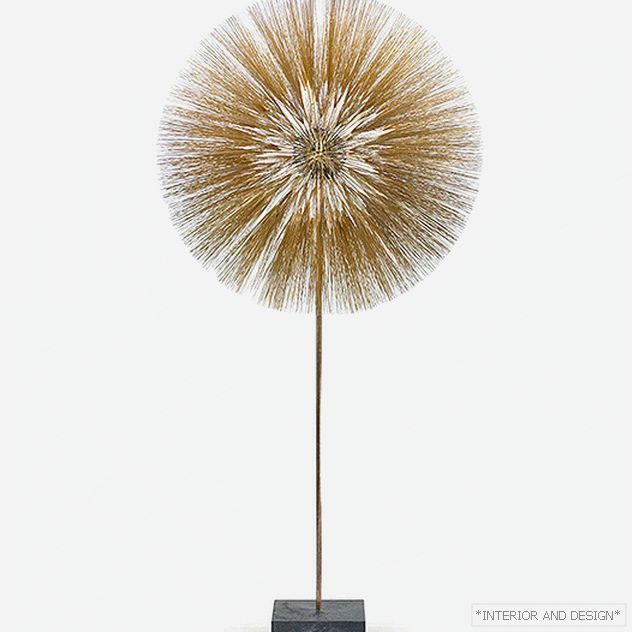 Sunburst sculpture. 1965. Patinated bronze, brass and steel. Height 104 cm, diameter 48 cm. Sold at Sotheby's in 2015 for $ 187,500.
Sunburst sculpture. 1965. Patinated bronze, brass and steel. Height 104 cm, diameter 48 cm. Sold at Sotheby's in 2015 for $ 187,500. In 1960, Bertoya began experimenting with sounding sculptures. He was fascinated by the vibrating, otherworldly sounds that make metal bars and gongs when the wind gusts or when human hands touch them. He made a lot of them, from different metals, from small ones, several dozen centimeters high, to almost 6 meters. It could be metal rods installed in one or several vertical rows or gongs of various shapes. The tonality depended on the thickness and frequency of the arrangement of the rods. Bertoya was so fascinated by this art that he converted his barn workshop into an acoustic studio, calling it Sonambient. The studio was filled with sounding sculptures, here Bertoya and his son Val gave concerts for acquaintances, here the sculptor recorded 11 music albums, which today are digitized and sold through the foundation of his name.
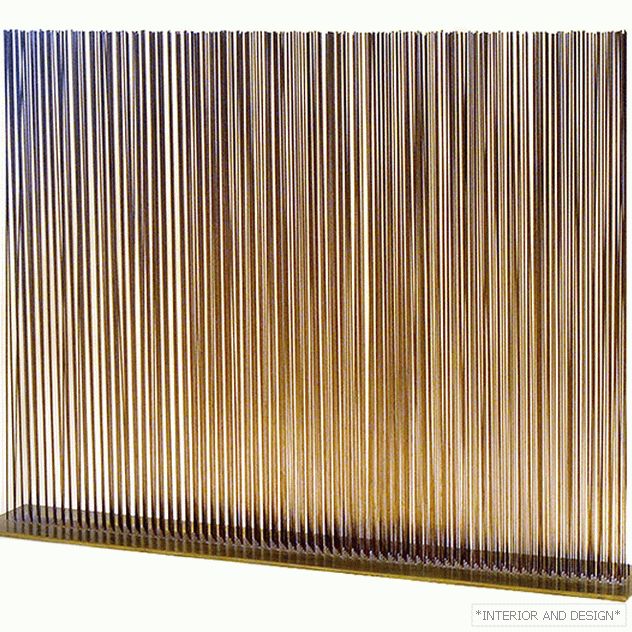 Layout of sound sculpture installed in front of the Standard Oil skyscraper in Chicago. 1974.
Layout of sound sculpture installed in front of the Standard Oil skyscraper in Chicago. 1974. Today, Sonambient is preserved in its original form, and the son of Bertoya still organizes concerts in it on sounding sculptures, supported by the foundation named after his father, led by his daughter Celia. Bertoya is buried next to Sonambient, under one of his creations - a giant gong. In 1978, he died of lung cancer. They say the disease was triggered by poisonous pairs of beryllium copper, which he used most often, considering it the best material for his works.

